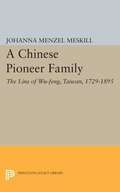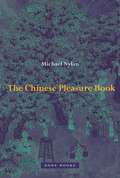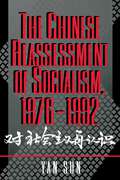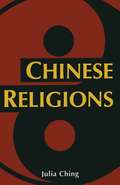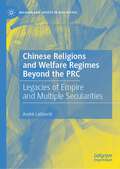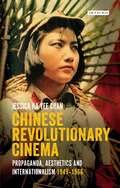- Table View
- List View
A Chinese Pioneer Family: The Lins of Wu-feng, Taiwan, 1729-1895 (PDF)
by Johanna Margarete MeskillIn an absorbing account of a frontier family's rise to local eminence, from its pioneer days in eighteenth-century Taiwan through its attainment of gentry status there a century later, Johanna Meskill presents not just a family history but a social history of late imperial China as well.Originally published in 1987.The Princeton Legacy Library uses the latest print-on-demand technology to again make available previously out-of-print books from the distinguished backlist of Princeton University Press. These editions preserve the original texts of these important books while presenting them in durable paperback and hardcover editions. The goal of the Princeton Legacy Library is to vastly increase access to the rich scholarly heritage found in the thousands of books published by Princeton University Press since its founding in 1905.
The Chinese Pleasure Book
by Michael NylanThis book takes up one of the most important themes in Chinese thought: the relation of pleasurable activities to bodily health and to the health of the body politic. Unlike Western theories of pleasure, early Chinese writings contrast pleasure not with pain but with insecurity, assuming that it is right and proper to seek and take pleasure, as well as experience short-term delight. Equally important is the belief that certain long-term relational pleasures are more easily sustained, as well as potentially more satisfying and less damaging. The pleasures that become deeper and more ingrained as the person invests time and effort to their cultivation include friendship and music, sharing with others, developing integrity and greater clarity, reading and classical learning, and going home. Each of these activities is explored through the early sources (mainly fourth century BC to the eleventh century AD), with new translations of both well-known and seldom-cited texts.
The Chinese Pleasure Book
by Michael NylanThis book takes up one of the most important themes in Chinese thought: the relation of pleasurable activities to bodily health and to the health of the body politic. Unlike Western theories of pleasure, early Chinese writings contrast pleasure not with pain but with insecurity, assuming that it is right and proper to seek and take pleasure, as well as experience short-term delight. Equally important is the belief that certain long-term relational pleasures are more easily sustained, as well as potentially more satisfying and less damaging. The pleasures that become deeper and more ingrained as the person invests time and effort to their cultivation include friendship and music, sharing with others, developing integrity and greater clarity, reading and classical learning, and going home. Each of these activities is explored through the early sources (mainly fourth century BC to the eleventh century AD), with new translations of both well-known and seldom-cited texts.
Chinese Political Culture
by Shiping Hua Andrew J. NathanUntil this book, there has been no comprehensive, methodologically aware study of all aspects of Chinese political culture. The book is organized into three major areas: Chinese identities and popular culture (regional identities, anti-politics attitudes, Hong Kong identity); public opinion surveys (the Beijing area, Chinese workers, the Shanghai area); and ideological debates (the "new" Confucianism, masculinity and Confucianism, why authoritarianism is popular in China, the decline of Chinese official ideology). Here is the first work that reveals just how much, how rapidly, and how dramatically China is changing and why our perceptions of China must keep pace.
Chinese Political Culture (Studies On Contemporary China)
by Shiping Hua Andrew J. NathanUntil this book, there has been no comprehensive, methodologically aware study of all aspects of Chinese political culture. The book is organized into three major areas: Chinese identities and popular culture (regional identities, anti-politics attitudes, Hong Kong identity); public opinion surveys (the Beijing area, Chinese workers, the Shanghai area); and ideological debates (the "new" Confucianism, masculinity and Confucianism, why authoritarianism is popular in China, the decline of Chinese official ideology). Here is the first work that reveals just how much, how rapidly, and how dramatically China is changing and why our perceptions of China must keep pace.
Chinese Porcelain in Colonial Mexico: The Material Worlds of an Early Modern Trade
by Meha PriyadarshiniThis book follows Chinese porcelain through the commodity chain, from its production in China to trade with Spanish Merchants in Manila, and to its eventual adoption by colonial society in Mexico. As trade connections increased in the early modern period, porcelain became an immensely popular and global product. This study focuses on one of the most exported objects, the guan. It shows how this porcelain jar was produced, made accessible across vast distances and how designs were borrowed and transformed into new creations within different artistic cultures. While people had increased access to global markets and products, this book argues that this new connectivity could engender more local outlooks and even heightened isolation in some places. It looks beyond the guan to the broader context of transpacific trade during this period, highlighting the importance and impact of Asian commodities in Spanish America.
Chinese Porcelain in Colonial Mexico: The Material Worlds of an Early Modern Trade
by Meha PriyadarshiniThis book follows Chinese porcelain through the commodity chain, from its production in China to trade with Spanish Merchants in Manila, and to its eventual adoption by colonial society in Mexico. As trade connections increased in the early modern period, porcelain became an immensely popular and global product. This study focuses on one of the most exported objects, the guan. It shows how this porcelain jar was produced, made accessible across vast distances and how designs were borrowed and transformed into new creations within different artistic cultures. While people had increased access to global markets and products, this book argues that this new connectivity could engender more local outlooks and even heightened isolation in some places. It looks beyond the guan to the broader context of transpacific trade during this period, highlighting the importance and impact of Asian commodities in Spanish America.
Chinese Power and Artificial Intelligence: Perspectives and Challenges (Asian Security Studies)
by William C. HannasThis book provides a comprehensive account of Chinese AI in its various facets, based on primary Chinese-language sources. China’s rise as an AI power is an event of importance to the world and a potential challenge to liberal democracies. Filling a gap in the literature, this volume is fully documented, data-driven, and presented in a scholarly format suitable for citation and for supporting downstream research, while also remaining accessible to laypersons. It brings together 15 recognized international experts to present a full treatment of Chinese artificial intelligence. The volume contains chapters on state, commercial, and foreign sources of China’s AI power; China’s AI talent, scholarship, and global standing; the impact of AI on China’s development of cutting-edge disciplines; China’s use of AI in military, cyber, and surveillance applications; AI safety, threat mitigation, and the technology’s likely trajectory. The book ends with recommendations drawn from the authors’ interactions with policymakers and specialists worldwide, aimed at encouraging AI’s healthy development in China and preparing the rest of the world to engage with it. This book will be of much interest to students of Chinese politics, science and technology studies, security studies and international relations.
Chinese Power and Artificial Intelligence: Perspectives and Challenges (Asian Security Studies)
by William C. Hannas Huey-Meei ChangThis book provides a comprehensive account of Chinese AI in its various facets, based on primary Chinese-language sources. China’s rise as an AI power is an event of importance to the world and a potential challenge to liberal democracies. Filling a gap in the literature, this volume is fully documented, data-driven, and presented in a scholarly format suitable for citation and for supporting downstream research, while also remaining accessible to laypersons. It brings together 15 recognized international experts to present a full treatment of Chinese artificial intelligence. The volume contains chapters on state, commercial, and foreign sources of China’s AI power; China’s AI talent, scholarship, and global standing; the impact of AI on China’s development of cutting-edge disciplines; China’s use of AI in military, cyber, and surveillance applications; AI safety, threat mitigation, and the technology’s likely trajectory. The book ends with recommendations drawn from the authors’ interactions with policymakers and specialists worldwide, aimed at encouraging AI’s healthy development in China and preparing the rest of the world to engage with it. This book will be of much interest to students of Chinese politics, science and technology studies, security studies and international relations.
Chinese Public Diplomacy: The Rise of the Confucius Institute (Routledge New Diplomacy Studies)
by Falk HartigThis book presents the first comprehensive analysis of Confucius Institutes (CIs), situating them as a tool of public diplomacy in the broader context of China’s foreign affairs. The study establishes the concept of public diplomacy as the theoretical framework for analysing CIs. By applying this frame to in-depth case studies of CIs in Europe and Oceania, it provides in-depth knowledge of the structure and organisation of CIs, their activities and audiences, as well as problems, challenges and potentials. In addition to examining CIs as the most prominent and most controversial tool of China’s charm offensive, this book also explains what the structural configuration of these institutes can tell us about China’s understanding of and approaches towards public diplomacy. The study demonstrates that, in contrast to their international counterparts, CIs are normally organised as joint ventures between international and Chinese partners in the field of education or cultural exchange. From this unique setting a more fundamental observation can be made, namely China’s willingness to engage and cooperate with foreigners in the context of public diplomacy. Overall, the author argues that by utilizing the current global fascination with Chinese language and culture, the Chinese government has found interested and willing international partners to co-finance the CIs and thus partially fund China’s international charm offensive. This book will be of much interest to students of public diplomacy, Chinese politics, foreign policy and international relations in general.
Chinese Public Diplomacy: The Rise of the Confucius Institute (Routledge New Diplomacy Studies)
by Falk HartigThis book presents the first comprehensive analysis of Confucius Institutes (CIs), situating them as a tool of public diplomacy in the broader context of China’s foreign affairs. The study establishes the concept of public diplomacy as the theoretical framework for analysing CIs. By applying this frame to in-depth case studies of CIs in Europe and Oceania, it provides in-depth knowledge of the structure and organisation of CIs, their activities and audiences, as well as problems, challenges and potentials. In addition to examining CIs as the most prominent and most controversial tool of China’s charm offensive, this book also explains what the structural configuration of these institutes can tell us about China’s understanding of and approaches towards public diplomacy. The study demonstrates that, in contrast to their international counterparts, CIs are normally organised as joint ventures between international and Chinese partners in the field of education or cultural exchange. From this unique setting a more fundamental observation can be made, namely China’s willingness to engage and cooperate with foreigners in the context of public diplomacy. Overall, the author argues that by utilizing the current global fascination with Chinese language and culture, the Chinese government has found interested and willing international partners to co-finance the CIs and thus partially fund China’s international charm offensive. This book will be of much interest to students of public diplomacy, Chinese politics, foreign policy and international relations in general.
Chinese Railways in the Era of High Speed (0)
by Zhenhua Chen Kingsley E. HaynesAfter a decade of steady investment and construction, Chinese railways have evolved into an era of high-speed. This book has two objectives. The first is to introduce the Chinese railway system to an international audience and document the evolutionary process of railway development in China. For the first time, this book clarifies the Chinese experience with HSR deployment and details the economic and physical achievements and related managerial issues and institutional challenges. The second objective is to discuss and analyze critical concerns regarding Chinese railway operations, management and institutional structure. This book analyses best practices of railway reform, reform strategies and considers how to improve China's related institutions. This research reflects on experiences in other countries and policy implications for the Chinese railway system. The book makes recommendations for how to improve the capability and capacity of institutions and organizations, in order to achieve sustainable development of the Chinese HSR system.
The Chinese Reassessment of Socialism, 1976-1992
by Yan SunA momentous debate has been unfolding in China over the last fifteen years, only intermittently in public view, concerning the merits of socialism as a philosophy of social justice and as a program for national development. Just as Deng Xiaoping's better advertised experiment with market- based reforms has challenged Marxist-Leninist dogma on economic policy, the years since the death of Mao Zedong have seen a profound reexamination of a more basic question: to what extent are the root problems of the system due to Chinese socialism and Marxism generally? Here Yan Sun gathers a remarkable group of primary materials, drawn from an unusual range of sources, to present the most systematic and comprehensive study of post-Mao reappraisal of China's socialist theory and practice. Rejecting an assumption often made in the West, that Chinese socialist thought has little bearing on politics and policymaking, Sun takes the arguments of the post-Mao era seriously on their own terms. She identifies the major factions in the debate, reveals the interplay among official and unofficial forces, and charts the development of the debate from an initially parochial concern with problems raised by Chinese practice to a grand critique of the theory of socialism itself. She concludes with an enlightening comparison of the reassessments undertaken by Deng Xiaoping with those of Gorbachev, linking them to the divergent outcomes of reform and revolution in their respective countries.
The Chinese Reassessment of Socialism, 1976-1992
by Yan SunA momentous debate has been unfolding in China over the last fifteen years, only intermittently in public view, concerning the merits of socialism as a philosophy of social justice and as a program for national development. Just as Deng Xiaoping's better advertised experiment with market- based reforms has challenged Marxist-Leninist dogma on economic policy, the years since the death of Mao Zedong have seen a profound reexamination of a more basic question: to what extent are the root problems of the system due to Chinese socialism and Marxism generally? Here Yan Sun gathers a remarkable group of primary materials, drawn from an unusual range of sources, to present the most systematic and comprehensive study of post-Mao reappraisal of China's socialist theory and practice. Rejecting an assumption often made in the West, that Chinese socialist thought has little bearing on politics and policymaking, Sun takes the arguments of the post-Mao era seriously on their own terms. She identifies the major factions in the debate, reveals the interplay among official and unofficial forces, and charts the development of the debate from an initially parochial concern with problems raised by Chinese practice to a grand critique of the theory of socialism itself. She concludes with an enlightening comparison of the reassessments undertaken by Deng Xiaoping with those of Gorbachev, linking them to the divergent outcomes of reform and revolution in their respective countries.
A Chinese Rebel beyond the Great Wall: The Cultural Revolution and Ethnic Pogrom in Inner Mongolia (Silk Roads)
by TJ Cheng Uradyn E. Bulag Mark SeldenA striking first-person account of the Cultural Revolution in Inner Mongolia, embedded in a close examination of the historical evidence on China’s minority nationality policies to the present. During the Great Leap Forward, as hundreds of thousands of Chinese famine refugees headed to Inner Mongolia, Cheng Tiejun arrived in 1959 as a middle school student. In 1966, when the PRC plunged into the Cultural Revolution, he joined the Red Guards just as Inner Mongolia’s longtime leader, Ulanhu, was purged. With the military in control, and with deepening conflict with the Soviet Union and its ally Mongolia on the border, Mongols were accused of being nationalists and traitors. A pogrom followed, taking more than 16,000 Mongol lives, the heaviest toll anywhere in China. At the heart of this book are Cheng’s first-person recollections of his experiences as a rebel. These are complemented by a close examination of the documentary record of the era from the three coauthors. The final chapter offers a theoretical framework for Inner Mongolia’s repression. The repression’s goal, the authors show, was not to destroy the Mongols as a people or as a culture—it was not a genocide. It was, however, a “politicide,” an attempt to break the will of a nationality to exercise leadership of their autonomous region. This unusual narrative provides urgently needed primary source material to understand the events of the Cultural Revolution, while also offering a novel explanation of contemporary Chinese minority politics involving the Uyghurs, Tibetans, and Mongols.
A Chinese Rebel beyond the Great Wall: The Cultural Revolution and Ethnic Pogrom in Inner Mongolia (Silk Roads)
by TJ Cheng Uradyn E. Bulag Mark SeldenA striking first-person account of the Cultural Revolution in Inner Mongolia, embedded in a close examination of the historical evidence on China’s minority nationality policies to the present. During the Great Leap Forward, as hundreds of thousands of Chinese famine refugees headed to Inner Mongolia, Cheng Tiejun arrived in 1959 as a middle school student. In 1966, when the PRC plunged into the Cultural Revolution, he joined the Red Guards just as Inner Mongolia’s longtime leader, Ulanhu, was purged. With the military in control, and with deepening conflict with the Soviet Union and its ally Mongolia on the border, Mongols were accused of being nationalists and traitors. A pogrom followed, taking more than 16,000 Mongol lives, the heaviest toll anywhere in China. At the heart of this book are Cheng’s first-person recollections of his experiences as a rebel. These are complemented by a close examination of the documentary record of the era from the three coauthors. The final chapter offers a theoretical framework for Inner Mongolia’s repression. The repression’s goal, the authors show, was not to destroy the Mongols as a people or as a culture—it was not a genocide. It was, however, a “politicide,” an attempt to break the will of a nationality to exercise leadership of their autonomous region. This unusual narrative provides urgently needed primary source material to understand the events of the Cultural Revolution, while also offering a novel explanation of contemporary Chinese minority politics involving the Uyghurs, Tibetans, and Mongols.
Chinese Religion and Familism: The Basis of Chinese Culture, Society, and Government
by Jordan PaperReflecting on over half a century of study on Chinese culture, Jordan Paper explores new ways of approaching religion in China. Moving away from using Christianity as a model for examination, which has led to considerable misunderstandings between China and the West, Paper instead applies the paradigm of Familism to Chinese religion. By looking through the lens of Familism, which emphasises the importance of the family unit, Paper argues that we can understand the basis of Chinese culture, society, government, and religion. In the book, Paper explains how, when and why Familism appears in the development of human culture in the Neolithic period, as well as its ramifications in more complex societies, using the imperial Chinese state as an example. The discussion in the book includes how the Chinese state can be understood as a religious institution; the role of spirit possession; the relationship of other religions in China to Chinese Religion, including Buddhism, Daoism and Judaism; and the issue of freedom of religion in contemporary China. Chinese Religion and Familism not only challenges the discipline's perception of Chinese religion, but all of the religions of East Asia, indigenous sub-Saharan African religions, Polynesian Religion, and elsewhere.
Chinese Religion and Familism: The Basis of Chinese Culture, Society, and Government
by Jordan PaperReflecting on over half a century of study on Chinese culture, Jordan Paper explores new ways of approaching religion in China. Moving away from using Christianity as a model for examination, which has led to considerable misunderstandings between China and the West, Paper instead applies the paradigm of Familism to Chinese religion. By looking through the lens of Familism, which emphasises the importance of the family unit, Paper argues that we can understand the basis of Chinese culture, society, government, and religion. In the book, Paper explains how, when and why Familism appears in the development of human culture in the Neolithic period, as well as its ramifications in more complex societies, using the imperial Chinese state as an example. The discussion in the book includes how the Chinese state can be understood as a religious institution; the role of spirit possession; the relationship of other religions in China to Chinese Religion, including Buddhism, Daoism and Judaism; and the issue of freedom of religion in contemporary China. Chinese Religion and Familism not only challenges the discipline's perception of Chinese religion, but all of the religions of East Asia, indigenous sub-Saharan African religions, Polynesian Religion, and elsewhere.
Chinese Religions (Themes in Comparative Religion)
by J. ChingThis is a comprehensive work on the religions of China. As such, it includes an introduction giving an overview of the subject, and the special themes treated in the book, as well as detailed chapters on ancient religions, Confucianism, Taoism, Buddhism, Chinese Islam, Christianity in China as well as popular religion. Throughout the book, care is taken to present both the philosophical teachings as well as the religious practices of the religious traditions, and reflections are offered regarding their present situation and future prospects. Comparisons are offered with other religions, especially Christianity.
Chinese Religions and Welfare Regimes Beyond the PRC: Legacies of Empire and Multiple Secularities (Religion and Society in Asia Pacific)
by André LalibertéThis book presents the welfare regime of societies of Chinese heritage as a liminal space where religious and state authorities compete with each other for legitimacy. It offers a path-breaking perspective on relations between religion and state in East Asia, presenting how the governments of industrial societies try to harness the human resources of religious associations to assist in the delivery of social services. The book provides background to the intermingling of Buddhism and the state prior to 1949; and the continuation of that intertwinement in Taiwan and in other societies where live many people of Chinese heritage since then. The main contribution of this work is its detailed account of Buddhist philanthropy as viewed from the perspectives of the state, civil society, and Buddhists. This book will appeal to academics in social sciences and humanities and broader audiences interested by the social role of religions, charity, and NGOs, in social policy implementation. It explores why governments turn to Buddhist followers and their leaders and presents a detailed view of Buddhist philanthropy. This book contributes to our understanding of secularity in non-Western societies, as influenced by religions other than Christianity.
Chinese Revolution in Practice: From Movement to the State (Routledge Studies in Modern History)
by Guo WuThis book employs multiple case studies to explore how the Chinese communist revolution began as an ideology-oriented intellectual movement aimed at improving society before China’s transformation into a state that suppresses dissenting voices by outsourcing its power of coercion and incarceration. The author examines the movement’s methods of early self-organization, grass-roots level engagement, creation of new modes of expression and popular art forms, manipulation of collective memory, and invention of innovative ways of mass incarceration. Covering developments from 1920 to 1970, the book considers a wide range of Chinese individuals and groups, from early Marxists to political prisoners in the PRC, to illustrate a dynamic, interactive process in which the state and individuals contend with each other. It argues that revolutionary practices in modern China have created a regime that can be conceptualized as an “ideology-military-propaganda” state that prompts further reflection on the relationships between revolution and the state, the state and collective articulation and memory, and the state and reflective individuals in a global context. Illustrating the continuity of the Chinese revolution and past decades’ socialist practices and mechanisms, this study is an ideal resource for scholars of Chinese history, politics, and twentieth-century revolutions.
Chinese Revolution in Practice: From Movement to the State (Routledge Studies in Modern History)
by Guo WuThis book employs multiple case studies to explore how the Chinese communist revolution began as an ideology-oriented intellectual movement aimed at improving society before China’s transformation into a state that suppresses dissenting voices by outsourcing its power of coercion and incarceration. The author examines the movement’s methods of early self-organization, grass-roots level engagement, creation of new modes of expression and popular art forms, manipulation of collective memory, and invention of innovative ways of mass incarceration. Covering developments from 1920 to 1970, the book considers a wide range of Chinese individuals and groups, from early Marxists to political prisoners in the PRC, to illustrate a dynamic, interactive process in which the state and individuals contend with each other. It argues that revolutionary practices in modern China have created a regime that can be conceptualized as an “ideology-military-propaganda” state that prompts further reflection on the relationships between revolution and the state, the state and collective articulation and memory, and the state and reflective individuals in a global context. Illustrating the continuity of the Chinese revolution and past decades’ socialist practices and mechanisms, this study is an ideal resource for scholars of Chinese history, politics, and twentieth-century revolutions.
The Chinese Revolution on the Tibetan Frontier (Studies of the Weatherhead East Asian Institute, Columbia University)
by Benno WeinerIn The Chinese Revolution on the Tibetan Frontier, Benno Weiner provides the first in-depth study of an ethnic minority region during the first decade of the People's Republic of China: the Amdo region in the Sino-Tibetan borderland. Employing previously inaccessible local archives as well as other rare primary sources, he demonstrates that the Communist Party's goal in 1950s Amdo was not just state-building, but also nation-building. Such an objective required the construction of narratives and policies capable of convincing Tibetans of their membership in a wider political community.As Weiner shows, however, early efforts to gradually and organically transform a vast multiethnic empire into a singular nation-state lost out to a revolutionary impatience, demanding more immediate paths to national integration and socialist transformation. This led in 1958 to communization, then to large-scale rebellion and its brutal pacification. Rather than joining voluntarily, Amdo was integrated through the widespread, often indiscriminate use of violence, a violence that lingers in the living memory of Amdo Tibetans and others.
Chinese Revolutionary Cinema: Propaganda, Aesthetics and Internationalism 1949–1966 (International Library of the Moving Image (PDF) #48)
by Jessica Ka ChanEngaging with fiction films devoted to heroic tales from the decade and a half between 1949 and 1966, this book reconceives state propaganda as aesthetic experiments that not only radically transformed acting, cinematography and screenwriting in socialist China, but also articulated a new socialist film theory and criticism. Rooted in the interwar avant-garde and commercial cinema, Chinese revolutionary cinema, as a state cinema for the newly established People's Republic, adapted Chinese literature for the screen, incorporated Hollywood narration, appropriated Soviet montage theory and orchestrated a new, glamorous, socialist star culture. In the wake of decolonisation, Chinese film journals were quick to project and disseminate the country's redefined self-image to Asia, Africa and Latin America as they helped to create an alternative vision of modernity and internationalism. Revealing the historical contingency of the term 'propaganda', Chan uncovers the visual, aural, kinaesthetic, sexual and ideological dynamics that gave rise to a new aesthetic of revolutionary heroism in world cinema. Based on extensive archival research, this book's focus on the distinctive rhetoric of post-war socialist China will be of value to East Asian Cinema scholars, Chinese Studies academics and those interested in the history of twentieth-century socialist culture.
